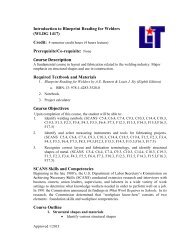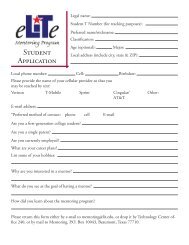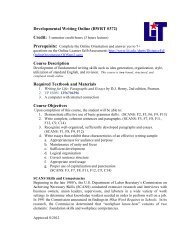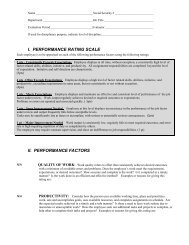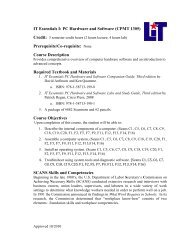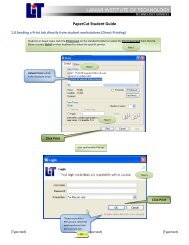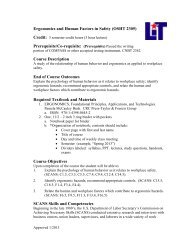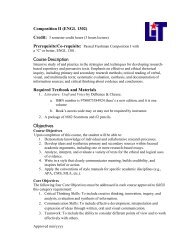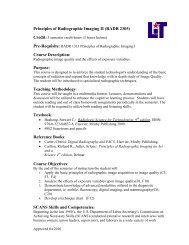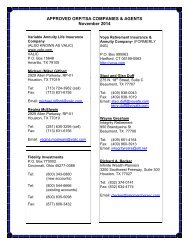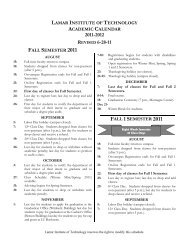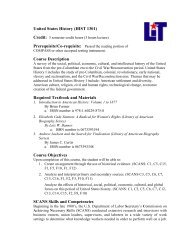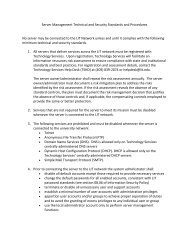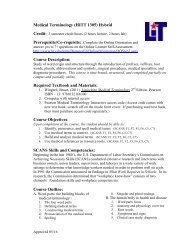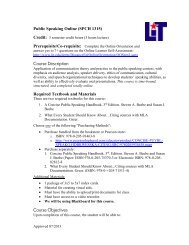LIT Master PLan PDF - Lamar Institute of Technology
LIT Master PLan PDF - Lamar Institute of Technology
LIT Master PLan PDF - Lamar Institute of Technology
Create successful ePaper yourself
Turn your PDF publications into a flip-book with our unique Google optimized e-Paper software.
ecommendations<br />
Materials (and Recycling)<br />
• Purchase materials responsibly as a campus.<br />
Know the sources <strong>of</strong> your supplies, such as paper.<br />
Purchase locally, minimizing the negative effects<br />
<strong>of</strong> transportation. Obtain supplies that are made<br />
from recycled materials or recyclable materials<br />
that do not contain harmful toxins.<br />
• Recycle: make it mandatory but easy for everyone<br />
on the campus. Provide an abundance <strong>of</strong> recycling<br />
stations that are well demarcated in buildings and<br />
around campus. Education on recycling is vital.<br />
Students, faculty and staff must understand the importance<br />
<strong>of</strong> recycling and how to properly recycle.<br />
• Do more business digitally. Transition some traditional<br />
textbooks or student records to digital ones.<br />
This can make a significant impact on the amount<br />
<strong>of</strong> waste generated on campus.<br />
• Construct buildings using a variety <strong>of</strong> lower impact<br />
materials, such as:<br />
▫ salvaged, refurbished or reused materials<br />
▫ recycled materials<br />
▫ regionally extracted, processed and manufactured<br />
materials<br />
▫ rapidly renewable materials<br />
▫ certified wood products<br />
• When possible, use existing structures for renovation.<br />
Site Development<br />
• Construct taller buildings with smaller footprints.<br />
Preserve valuable acreage by building up instead<br />
<strong>of</strong> out.<br />
• Place parking under shading to reduce the “heat”<br />
island effect.<br />
• Plan for “green” vegetated ro<strong>of</strong>s or ro<strong>of</strong>s made <strong>of</strong><br />
highly reflective “high albedo” materials. Much<br />
<strong>of</strong> a building’s heat gain is gathered from the sun<br />
beating on the ro<strong>of</strong>. By covering the ro<strong>of</strong> with<br />
plants or making the surface more reflective, a<br />
building’s energy usage can be significantly diminished.<br />
• Design cooler hardscapes across the <strong>LIT</strong> campus.<br />
Use open-grid paving instead <strong>of</strong> solid concrete or<br />
“high albedo” paving materials instead <strong>of</strong> asphalt.<br />
• Retain or restore as much open, green space as<br />
possible. Doing so will aid in water run-<strong>of</strong>f management.<br />
Water<br />
• Develop systems to collect, treat, and recycle<br />
grey water for irrigation and wastewater usage on<br />
campus. This is a major step in reducing the use <strong>of</strong><br />
potable water on landscapes.<br />
• Water-conserving plumbing fixtures (toilets,<br />
urinals, faucets, etc.) should be a campus standard.<br />
Replace old, high-flow fixtures with low-flow<br />
fixtures.<br />
• Use native plants and limit turf grasses for landscaping.<br />
These measures will reduce irrigation<br />
needs.<br />
Expand recycling to accommodate more<br />
campus sustainable programs.<br />
CAMPUS MASTER PLAN<br />
<strong>Lamar</strong> <strong>Institute</strong> <strong>of</strong> <strong>Technology</strong><br />
40



